Reflective Paper: Traditional vs. Contemporary Management Approaches
VerifiedAdded on 2023/01/04
|6
|1224
|46
Report
AI Summary
This reflective paper examines the evolution of management approaches, contrasting classical and contemporary perspectives. The paper begins by outlining key concepts learned throughout a semester, including the roles and tasks of management within an organization, and the specialized areas such as line, staff, and project management. It differentiates between classical models, such as the rational goal and internal process models, and contemporary approaches like contingency theory. The paper discusses the scientific management theory of F.W. Taylor and the Fayol model. The author reflects on the impact of these theories on modern business practices, highlighting the importance of contingency models for adapting to changing environments. Additionally, it covers Mintzberg's 10 roles of management and the internal and external factors affecting business. The paper concludes with a personal reflection on the course, identifying strengths in research and quick learning, and weaknesses in critical thinking and articulation, and outlines strategies for improvement.
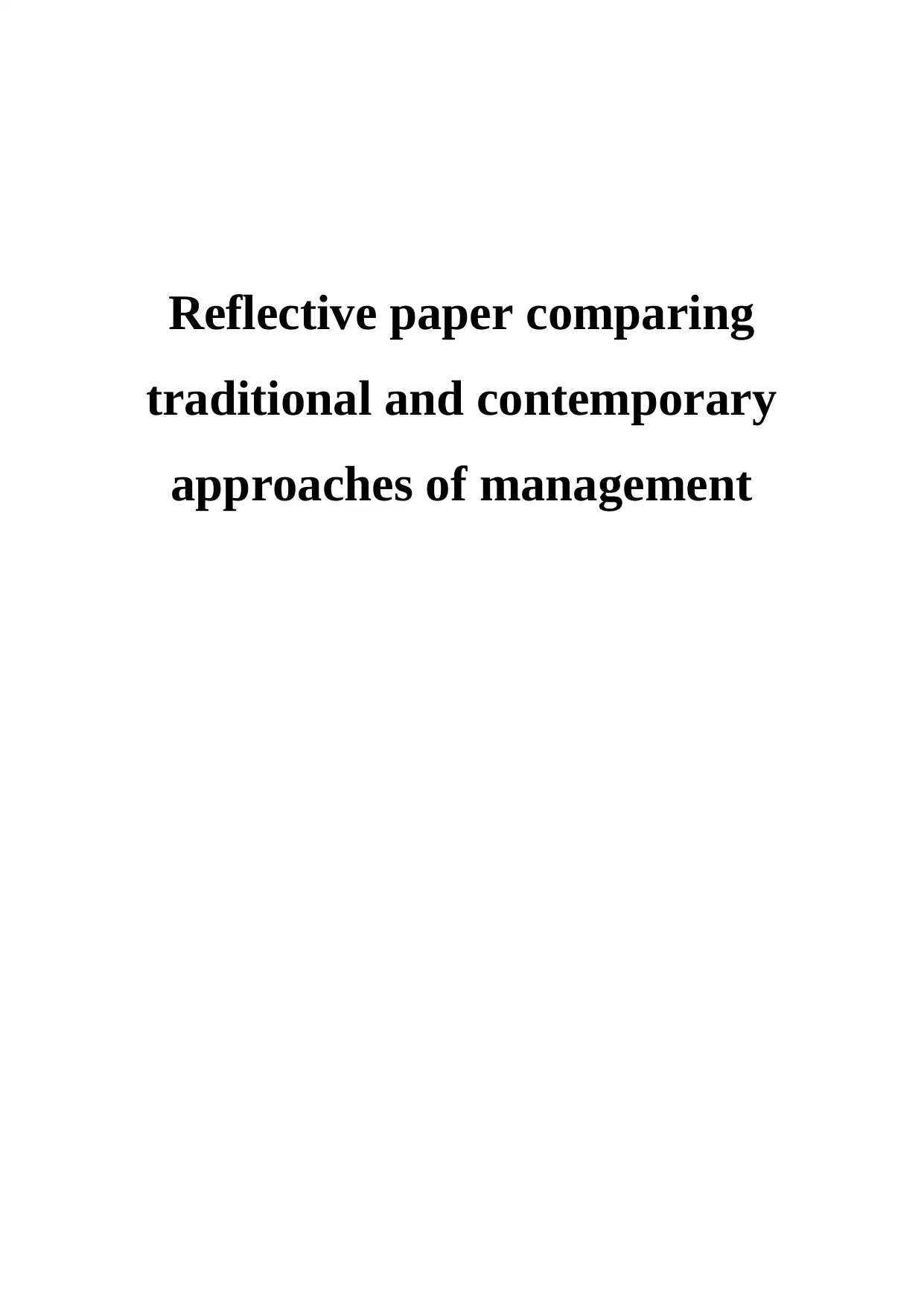
Reflective paper comparing
traditional and contemporary
approaches of management
traditional and contemporary
approaches of management
Paraphrase This Document
Need a fresh take? Get an instant paraphrase of this document with our AI Paraphraser
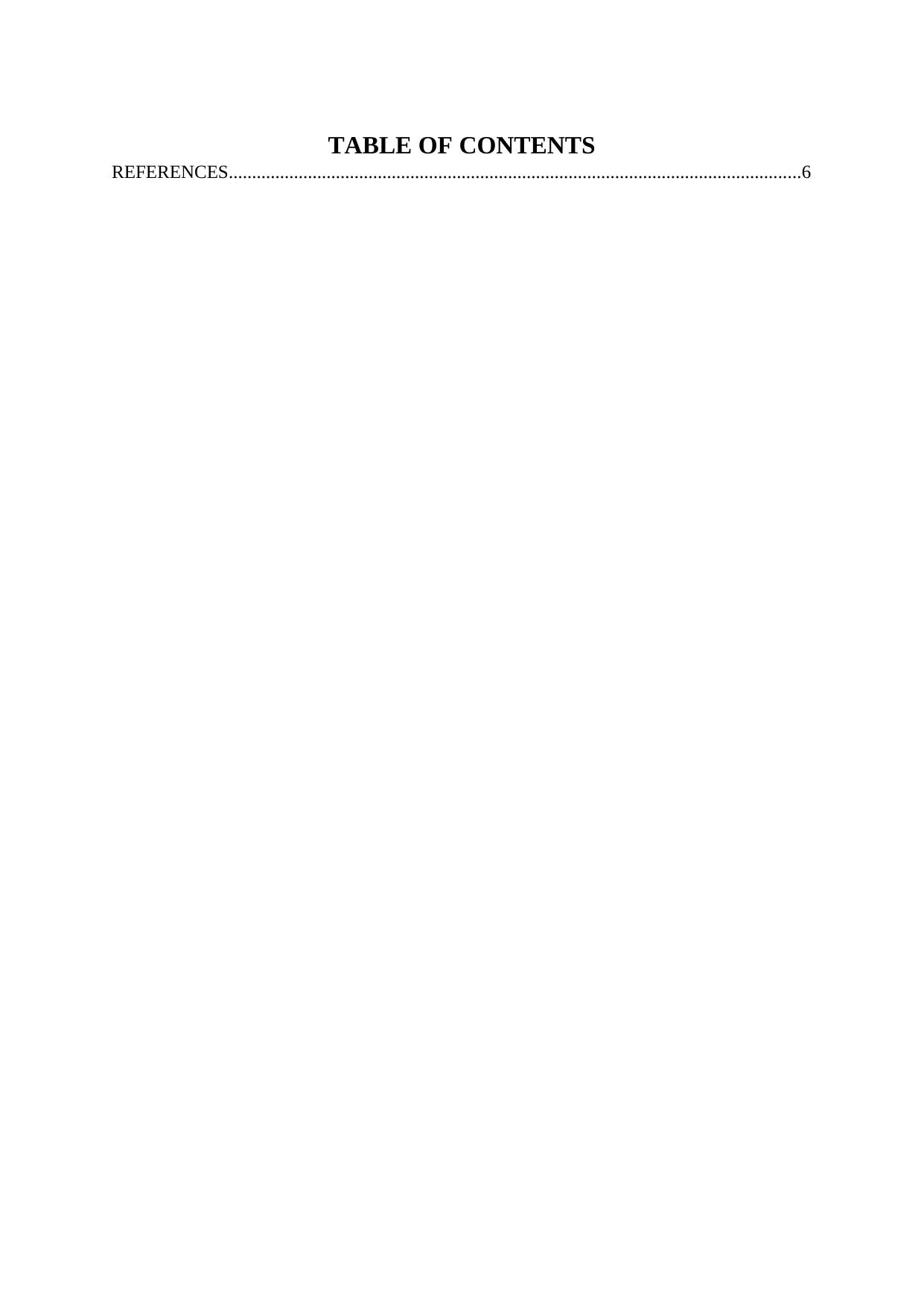
TABLE OF CONTENTS
REFERENCES...........................................................................................................................6
REFERENCES...........................................................................................................................6
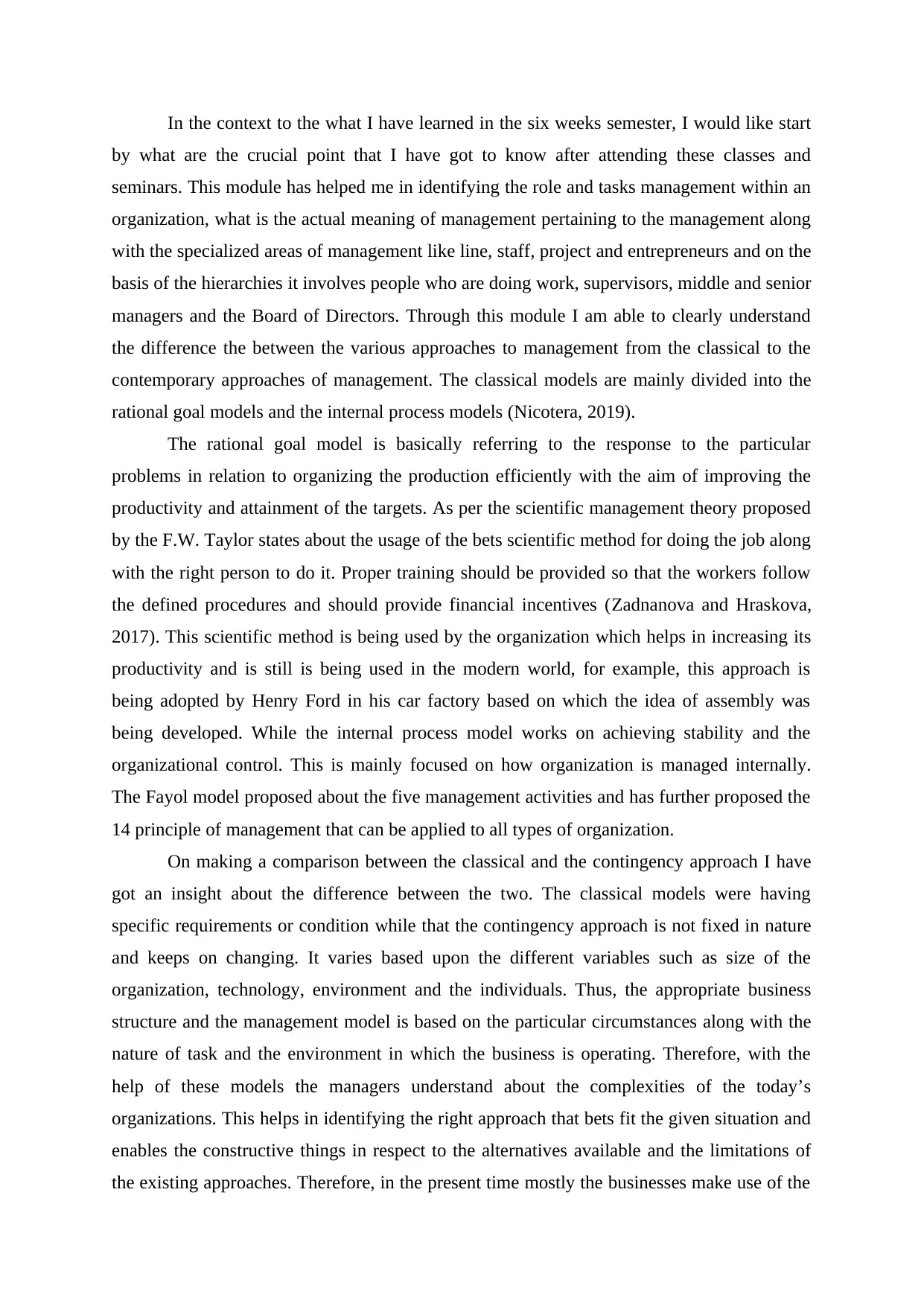
In the context to the what I have learned in the six weeks semester, I would like start
by what are the crucial point that I have got to know after attending these classes and
seminars. This module has helped me in identifying the role and tasks management within an
organization, what is the actual meaning of management pertaining to the management along
with the specialized areas of management like line, staff, project and entrepreneurs and on the
basis of the hierarchies it involves people who are doing work, supervisors, middle and senior
managers and the Board of Directors. Through this module I am able to clearly understand
the difference the between the various approaches to management from the classical to the
contemporary approaches of management. The classical models are mainly divided into the
rational goal models and the internal process models (Nicotera, 2019).
The rational goal model is basically referring to the response to the particular
problems in relation to organizing the production efficiently with the aim of improving the
productivity and attainment of the targets. As per the scientific management theory proposed
by the F.W. Taylor states about the usage of the bets scientific method for doing the job along
with the right person to do it. Proper training should be provided so that the workers follow
the defined procedures and should provide financial incentives (Zadnanova and Hraskova,
2017). This scientific method is being used by the organization which helps in increasing its
productivity and is still is being used in the modern world, for example, this approach is
being adopted by Henry Ford in his car factory based on which the idea of assembly was
being developed. While the internal process model works on achieving stability and the
organizational control. This is mainly focused on how organization is managed internally.
The Fayol model proposed about the five management activities and has further proposed the
14 principle of management that can be applied to all types of organization.
On making a comparison between the classical and the contingency approach I have
got an insight about the difference between the two. The classical models were having
specific requirements or condition while that the contingency approach is not fixed in nature
and keeps on changing. It varies based upon the different variables such as size of the
organization, technology, environment and the individuals. Thus, the appropriate business
structure and the management model is based on the particular circumstances along with the
nature of task and the environment in which the business is operating. Therefore, with the
help of these models the managers understand about the complexities of the today’s
organizations. This helps in identifying the right approach that bets fit the given situation and
enables the constructive things in respect to the alternatives available and the limitations of
the existing approaches. Therefore, in the present time mostly the businesses make use of the
by what are the crucial point that I have got to know after attending these classes and
seminars. This module has helped me in identifying the role and tasks management within an
organization, what is the actual meaning of management pertaining to the management along
with the specialized areas of management like line, staff, project and entrepreneurs and on the
basis of the hierarchies it involves people who are doing work, supervisors, middle and senior
managers and the Board of Directors. Through this module I am able to clearly understand
the difference the between the various approaches to management from the classical to the
contemporary approaches of management. The classical models are mainly divided into the
rational goal models and the internal process models (Nicotera, 2019).
The rational goal model is basically referring to the response to the particular
problems in relation to organizing the production efficiently with the aim of improving the
productivity and attainment of the targets. As per the scientific management theory proposed
by the F.W. Taylor states about the usage of the bets scientific method for doing the job along
with the right person to do it. Proper training should be provided so that the workers follow
the defined procedures and should provide financial incentives (Zadnanova and Hraskova,
2017). This scientific method is being used by the organization which helps in increasing its
productivity and is still is being used in the modern world, for example, this approach is
being adopted by Henry Ford in his car factory based on which the idea of assembly was
being developed. While the internal process model works on achieving stability and the
organizational control. This is mainly focused on how organization is managed internally.
The Fayol model proposed about the five management activities and has further proposed the
14 principle of management that can be applied to all types of organization.
On making a comparison between the classical and the contingency approach I have
got an insight about the difference between the two. The classical models were having
specific requirements or condition while that the contingency approach is not fixed in nature
and keeps on changing. It varies based upon the different variables such as size of the
organization, technology, environment and the individuals. Thus, the appropriate business
structure and the management model is based on the particular circumstances along with the
nature of task and the environment in which the business is operating. Therefore, with the
help of these models the managers understand about the complexities of the today’s
organizations. This helps in identifying the right approach that bets fit the given situation and
enables the constructive things in respect to the alternatives available and the limitations of
the existing approaches. Therefore, in the present time mostly the businesses make use of the
⊘ This is a preview!⊘
Do you want full access?
Subscribe today to unlock all pages.

Trusted by 1+ million students worldwide
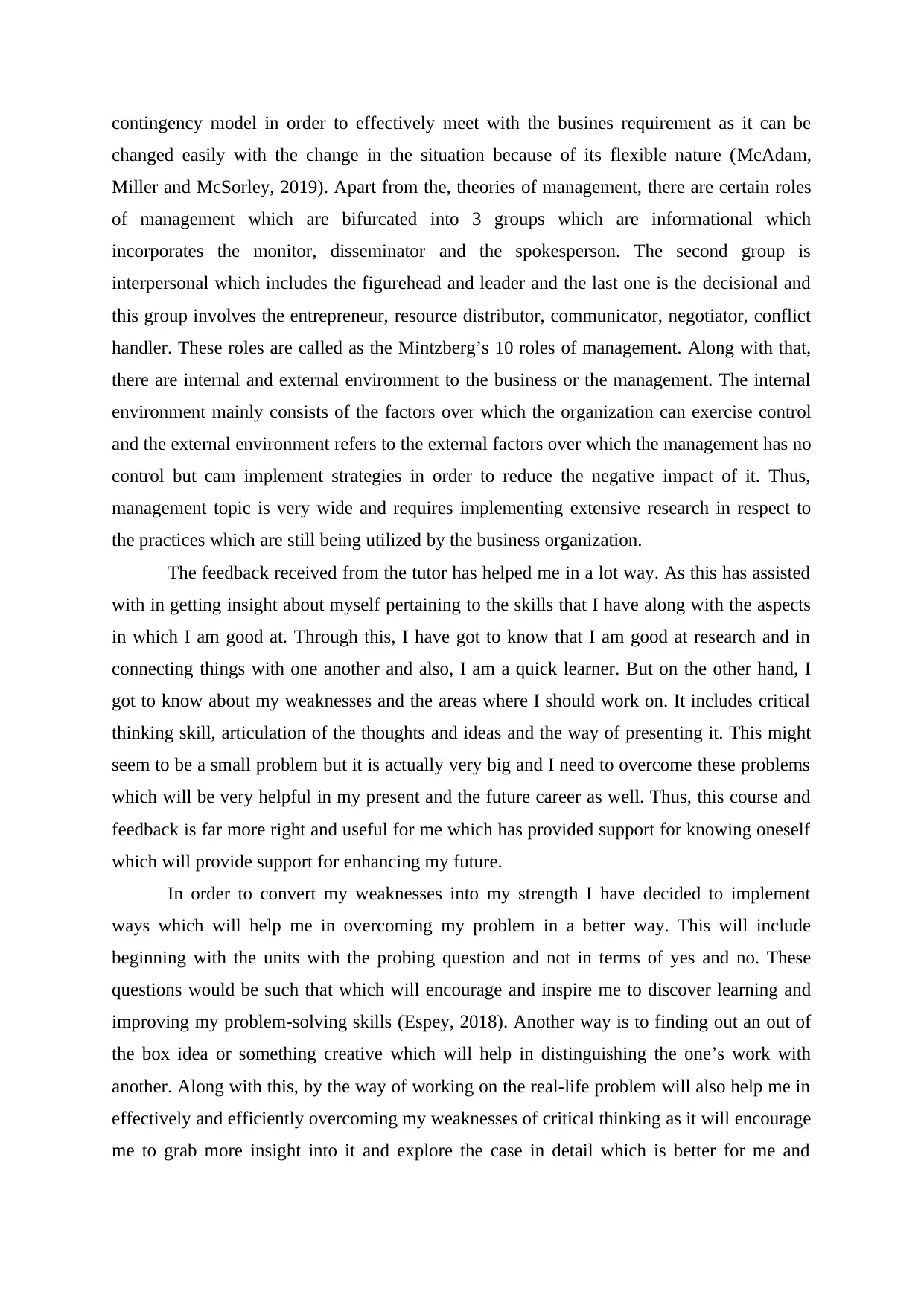
contingency model in order to effectively meet with the busines requirement as it can be
changed easily with the change in the situation because of its flexible nature (McAdam,
Miller and McSorley, 2019). Apart from the, theories of management, there are certain roles
of management which are bifurcated into 3 groups which are informational which
incorporates the monitor, disseminator and the spokesperson. The second group is
interpersonal which includes the figurehead and leader and the last one is the decisional and
this group involves the entrepreneur, resource distributor, communicator, negotiator, conflict
handler. These roles are called as the Mintzberg’s 10 roles of management. Along with that,
there are internal and external environment to the business or the management. The internal
environment mainly consists of the factors over which the organization can exercise control
and the external environment refers to the external factors over which the management has no
control but cam implement strategies in order to reduce the negative impact of it. Thus,
management topic is very wide and requires implementing extensive research in respect to
the practices which are still being utilized by the business organization.
The feedback received from the tutor has helped me in a lot way. As this has assisted
with in getting insight about myself pertaining to the skills that I have along with the aspects
in which I am good at. Through this, I have got to know that I am good at research and in
connecting things with one another and also, I am a quick learner. But on the other hand, I
got to know about my weaknesses and the areas where I should work on. It includes critical
thinking skill, articulation of the thoughts and ideas and the way of presenting it. This might
seem to be a small problem but it is actually very big and I need to overcome these problems
which will be very helpful in my present and the future career as well. Thus, this course and
feedback is far more right and useful for me which has provided support for knowing oneself
which will provide support for enhancing my future.
In order to convert my weaknesses into my strength I have decided to implement
ways which will help me in overcoming my problem in a better way. This will include
beginning with the units with the probing question and not in terms of yes and no. These
questions would be such that which will encourage and inspire me to discover learning and
improving my problem-solving skills (Espey, 2018). Another way is to finding out an out of
the box idea or something creative which will help in distinguishing the one’s work with
another. Along with this, by the way of working on the real-life problem will also help me in
effectively and efficiently overcoming my weaknesses of critical thinking as it will encourage
me to grab more insight into it and explore the case in detail which is better for me and
changed easily with the change in the situation because of its flexible nature (McAdam,
Miller and McSorley, 2019). Apart from the, theories of management, there are certain roles
of management which are bifurcated into 3 groups which are informational which
incorporates the monitor, disseminator and the spokesperson. The second group is
interpersonal which includes the figurehead and leader and the last one is the decisional and
this group involves the entrepreneur, resource distributor, communicator, negotiator, conflict
handler. These roles are called as the Mintzberg’s 10 roles of management. Along with that,
there are internal and external environment to the business or the management. The internal
environment mainly consists of the factors over which the organization can exercise control
and the external environment refers to the external factors over which the management has no
control but cam implement strategies in order to reduce the negative impact of it. Thus,
management topic is very wide and requires implementing extensive research in respect to
the practices which are still being utilized by the business organization.
The feedback received from the tutor has helped me in a lot way. As this has assisted
with in getting insight about myself pertaining to the skills that I have along with the aspects
in which I am good at. Through this, I have got to know that I am good at research and in
connecting things with one another and also, I am a quick learner. But on the other hand, I
got to know about my weaknesses and the areas where I should work on. It includes critical
thinking skill, articulation of the thoughts and ideas and the way of presenting it. This might
seem to be a small problem but it is actually very big and I need to overcome these problems
which will be very helpful in my present and the future career as well. Thus, this course and
feedback is far more right and useful for me which has provided support for knowing oneself
which will provide support for enhancing my future.
In order to convert my weaknesses into my strength I have decided to implement
ways which will help me in overcoming my problem in a better way. This will include
beginning with the units with the probing question and not in terms of yes and no. These
questions would be such that which will encourage and inspire me to discover learning and
improving my problem-solving skills (Espey, 2018). Another way is to finding out an out of
the box idea or something creative which will help in distinguishing the one’s work with
another. Along with this, by the way of working on the real-life problem will also help me in
effectively and efficiently overcoming my weaknesses of critical thinking as it will encourage
me to grab more insight into it and explore the case in detail which is better for me and
Paraphrase This Document
Need a fresh take? Get an instant paraphrase of this document with our AI Paraphraser
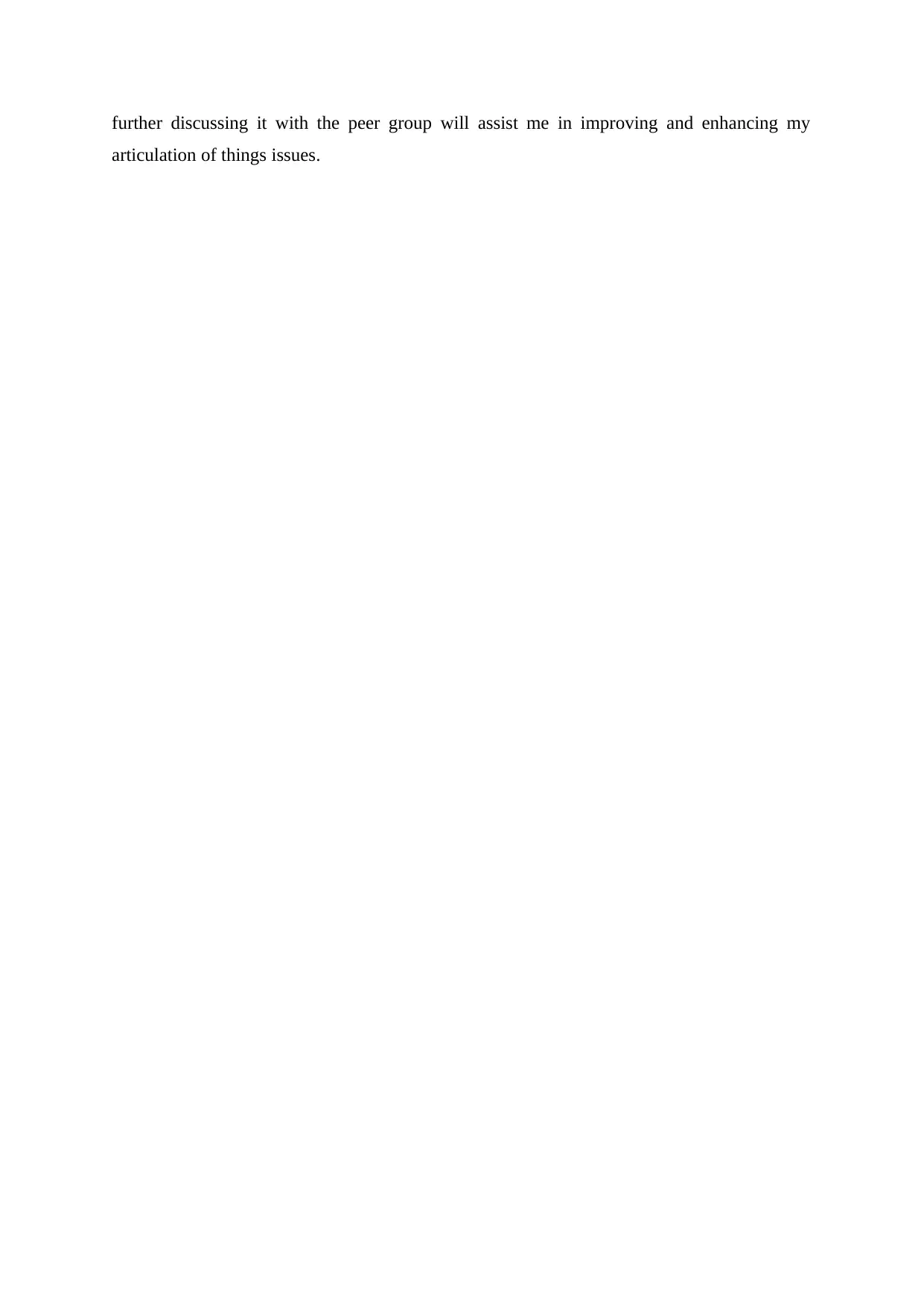
further discussing it with the peer group will assist me in improving and enhancing my
articulation of things issues.
articulation of things issues.
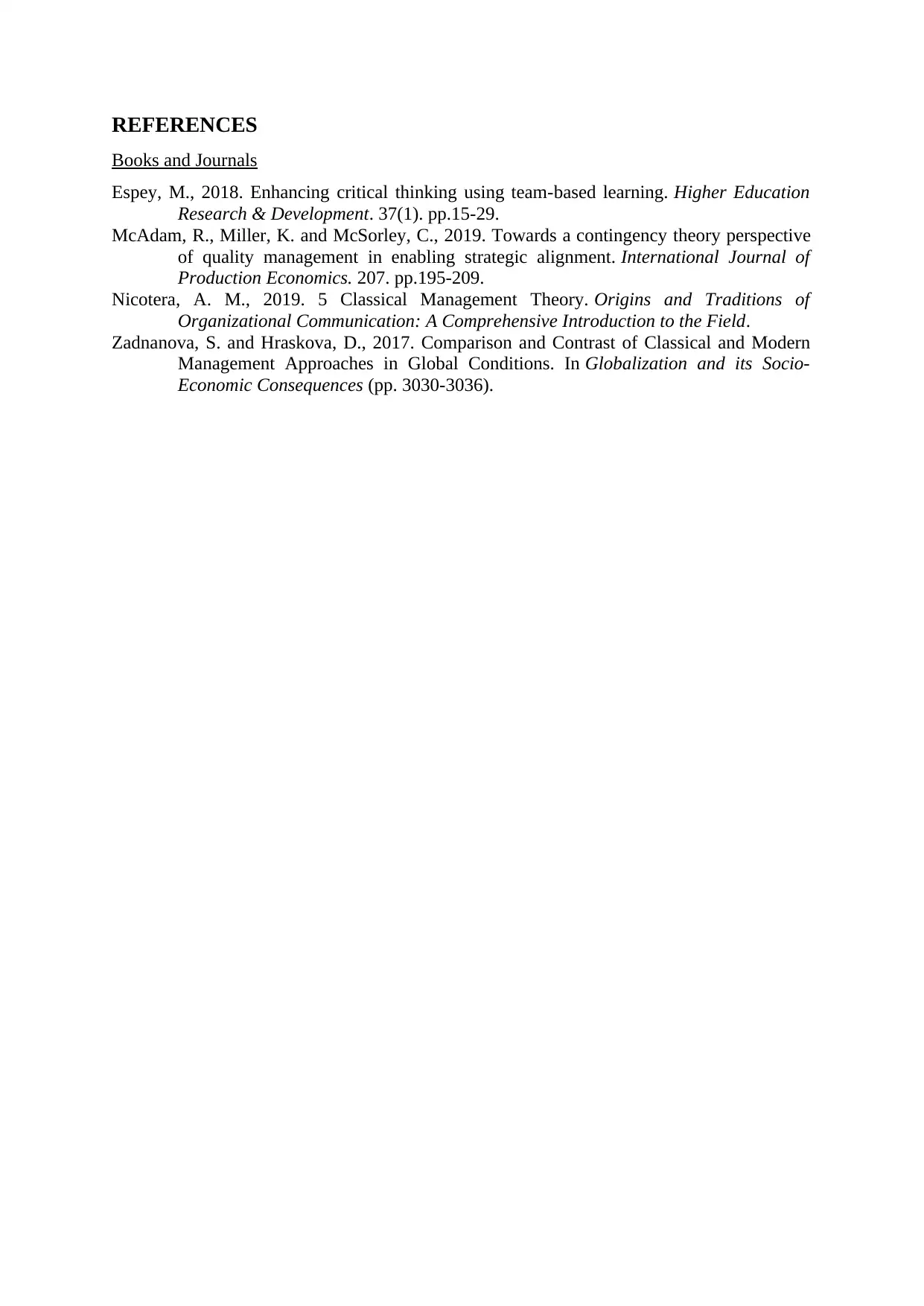
REFERENCES
Books and Journals
Espey, M., 2018. Enhancing critical thinking using team-based learning. Higher Education
Research & Development. 37(1). pp.15-29.
McAdam, R., Miller, K. and McSorley, C., 2019. Towards a contingency theory perspective
of quality management in enabling strategic alignment. International Journal of
Production Economics. 207. pp.195-209.
Nicotera, A. M., 2019. 5 Classical Management Theory. Origins and Traditions of
Organizational Communication: A Comprehensive Introduction to the Field.
Zadnanova, S. and Hraskova, D., 2017. Comparison and Contrast of Classical and Modern
Management Approaches in Global Conditions. In Globalization and its Socio-
Economic Consequences (pp. 3030-3036).
Books and Journals
Espey, M., 2018. Enhancing critical thinking using team-based learning. Higher Education
Research & Development. 37(1). pp.15-29.
McAdam, R., Miller, K. and McSorley, C., 2019. Towards a contingency theory perspective
of quality management in enabling strategic alignment. International Journal of
Production Economics. 207. pp.195-209.
Nicotera, A. M., 2019. 5 Classical Management Theory. Origins and Traditions of
Organizational Communication: A Comprehensive Introduction to the Field.
Zadnanova, S. and Hraskova, D., 2017. Comparison and Contrast of Classical and Modern
Management Approaches in Global Conditions. In Globalization and its Socio-
Economic Consequences (pp. 3030-3036).
⊘ This is a preview!⊘
Do you want full access?
Subscribe today to unlock all pages.

Trusted by 1+ million students worldwide
1 out of 6
Related Documents
Your All-in-One AI-Powered Toolkit for Academic Success.
+13062052269
info@desklib.com
Available 24*7 on WhatsApp / Email
![[object Object]](/_next/static/media/star-bottom.7253800d.svg)
Unlock your academic potential
Copyright © 2020–2025 A2Z Services. All Rights Reserved. Developed and managed by ZUCOL.


